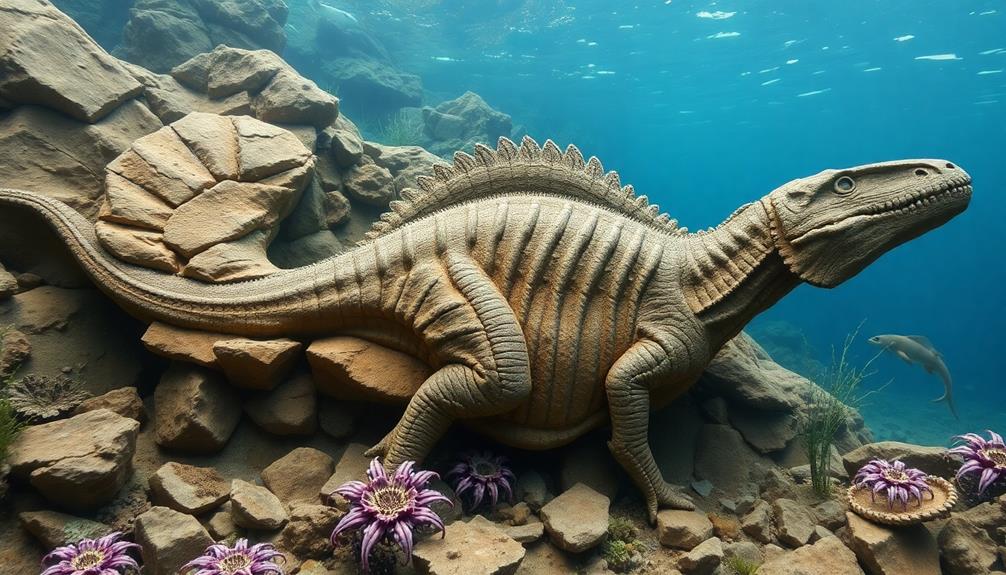Nothosaurus ruled the Triassic seas, thriving as a skilled predator with a unique blend of aquatic and terrestrial traits. You'd be amazed to learn about its long, flat skull and sharp teeth, perfect for catching fish and squid. Growing up to seven meters long, it swam efficiently with a paddle-like tail and limbs. This marine reptile inhabited shallow and deep waters across Europe, Asia, and North Africa. Its evolutionary journey marks a significant shift towards aquatic life. Curious about how it influenced future marine reptiles? There's much more to uncover about this fascinating ancient creature!
Key Takeaways
- Nothosaurus thrived during the Triassic period, adapting to aquatic life while retaining some terrestrial features.
- It was an efficient predator, utilizing sharp teeth and unique feeding techniques to capture fish and squid.
- Fossil evidence indicates a wide geographical range, with discoveries in Asia, North Africa, and Europe.
- Nothosaurus played a crucial role in the evolutionary lineage of marine reptiles, influencing species like plesiosaurs.
- Its adaptations reflect significant evolutionary milestones, marking a successful transition from land to marine environments.
Overview of Nothosaurus

Originating during the Triassic period, Nothosaurus was a remarkable genus of marine reptiles that flourished between 251 million and 200 million years ago.
These marine reptiles were uniquely adapted to thrive in aquatic environments while still retaining certain terrestrial features. With slender bodies and long necks, Nothosaurs could glide effortlessly through the water, making them efficient hunters of fish and squid. Their adaptability is reminiscent of modern systems that improve efficiency, such as noise reduction technology, which enhances comfort without disturbing daily activities.
Fossil evidence reveals that these creatures had a wide geographical range, with remains discovered across southwestern and eastern Asia, North Africa, and Europe. This diversity indicates that they occupied various marine ecosystems, showcasing their adaptability.
Growing up to seven meters in length, the Nothosaurus featured a long, flat skull lined with numerous pointed teeth, perfectly suited for capturing prey.
Nothosaurus played a pivotal role in the evolutionary lineage of marine reptiles, paving the way for future species like plesiosaurs. Their adaptations for feeding and locomotion in water highlight their significance in the Triassic seas.
As you explore the history of marine reptiles, Nothosaurus stands out as a fascinating example of evolution in action, bridging the gap between land and sea.
Physical Characteristics

Nothosaurus showcased a range of fascinating physical characteristics that made it well-suited for life in the water. With long, flat skulls and large openings, these marine reptiles had numerous pointed teeth designed for catching fish and squid. Growing up to seven meters in length, their streamlined, elongated bodies helped them glide through the ocean effortlessly. The eel-like flat tail further enhanced their swimming abilities, allowing them to navigate their aquatic environment with ease.
Curiously, just as Nothosaurus adapted to its environment, certain modern beverages like coffee have been linked to improved cognitive function and mood enhancement, showcasing how evolution and health can intertwine in various forms improved cognitive function.
While Nothosaurs featured paddle-like limbs, they weren't as specialized for swimming as those of more advanced marine reptiles like plesiosaurs. Nonetheless, their flexible body structure enabled undulating movement through the water, complemented by limb swimming for propulsion.
A unique closed palate separated their air and food passages, allowing them to breathe while actively hunting prey.
This combination of features made Nothosaurus a remarkable predator of the Triassic seas, efficiently adapting to its environment and thriving in the diverse marine ecosystem. Its physical attributes distinguish it among the marine reptiles of its time, showcasing the evolutionary innovations that allowed it to flourish in an ever-changing world.
Habitat and Distribution

During the Triassic period, Nothosaurus roamed a variety of marine environments across Europe, Asia, and North Africa.
These fascinating marine reptiles thrived in diverse ecosystems, showcasing their adaptability to both shallow coastal waters and deeper oceanic habitats. The fossil evidence emphasizes their ability to occupy different aquatic environments, highlighting their evolutionary flexibility.
Additionally, understanding the behaviors of marine reptiles can help in recognizing patterns in their environments, much like identifying gaslighting tactics in toxic relationships.
Here are some key points about Nothosaurus' habitat and distribution:
- Fossils were primarily found in Europe, Asia, and North Africa, indicating a wide geographical range.
- They inhabited various ecological niches, contributing to the complexity of Triassic marine life.
- Nothosaurus thrived in both shallow and deeper marine environments.
- The discovery of their tracks in China suggests they were widespread and offered insights into their behavior.
- Their presence in numerous fossil sites reflects their adaptability to changing marine conditions.
Exploring these habitats not only reveals the versatility of Nothosaurus but also provides a glimpse into the rich marine ecosystems of the Triassic period.
Evolutionary Significance

Nothosaurus marks an essential shift from land to sea, showcasing how reptiles adapted to aquatic life during the Triassic period.
Its unique features, like a long skull and sharp teeth, reveal effective strategies for survival in marine environments.
This adaptation can be paralleled with the advancements in Web 3.0, where innovative technologies allow for enhanced privacy and data ownership in various applications.
Understanding these evolutionary changes helps you appreciate the broader context of marine reptile development and their ecological roles.
Transition to Aquatic Life
The shift to an aquatic lifestyle represents a remarkable evolutionary milestone for reptiles, showcasing how life on land adapted to the challenges of marine environments. During the Triassic Period, Nothosaurus emerged as a prime example of this conversion to aquatic life, evolving from terrestrial ancestors over 200 million years ago.
This evolutionary progression mirrors the advancements seen in other species adapting to different environments, much like the innovations in energy-efficient technology for modern systems.
Key adaptations that facilitated this change include:
- Elongated bodies: Streamlined for efficient swimming.
- Paddle-like limbs: Perfectly designed for propulsion through water.
- Specialized skull structures: Enhanced feeding capabilities while swimming.
- Closed palate: Allowed separation of air and food passages for effective breathing.
- Diverse marine habitats: Evidence shows Nothosaurus thrived in various ecosystems, aiding marine life recovery post-extinction.
These adaptations not only allowed Nothosaurus to navigate and hunt in the ocean but also marked a pivotal progression in the evolution of marine reptiles.
Serving as an ancestor to later groups like plesiosaurs, Nothosaurus highlights the significance of the conversion to aquatic life, illustrating how terrestrial reptiles evolved to conquer the seas.
Evolutionary Adaptations for Survival
With its remarkable adaptations, Nothosaurus illustrates how evolutionary changes enable survival in diverse environments. Evolving from terrestrial reptiles, it made a significant change to an aquatic lifestyle during the Triassic period. Its long, flat skull and numerous pointed teeth reveal key evolutionary adaptations for a predatory diet, allowing it to efficiently catch fish and squid in various marine habitats.
Similar to how tiny houses adapt to their surroundings, Nothosaurus's evolutionary path showcases the importance of understanding legalities and zoning regulations for tiny houses in ensuring successful adaptation.
Nothosaurus also showcased a unique locomotion technique, utilizing both body undulation and its paddle-like limbs. This combination granted it the ability to navigate effectively through different aquatic ecosystems, enhancing its chances of survival.
Curiously, it retained some terrestrial features, bridging the gap between land-dwelling reptiles and fully aquatic marine reptiles like plesiosaurs. This evolutionary significance underscores its adaptability, demonstrating how creatures can thrive in changing environments.
Fossil discoveries of Nothosaurus across Europe, Asia, and North Africa further emphasize its wide geographical range and adaptability during a critical recovery period following the Permian extinction.
These evolutionary adaptations not only highlight Nothosaurus's unique role in the Triassic seas but also reflect the dynamic nature of life on Earth as species evolve and adapt to their surroundings.
Feeding Mechanisms and Behavior

When you look at Nothosaurs, you'll notice their unique feeding techniques stand out.
They used a rowing motion with their forelimbs to stir up prey from the seabed, showcasing their effective adaptation to the marine environment.
Their diet likely included a variety of marine organisms, similar to how hamsters require a balanced diet of fresh fruits and vegetables to thrive proper diet for hamsters.
Plus, their cooperative hunting behavior hints at a social aspect to their feeding strategies that helped them succeed in capturing slippery marine life.
Unique Feeding Techniques
Nothosaurs thrived in their marine environments thanks to their unique feeding techniques, which combined agility and precision.
These fascinating creatures were adept at scooping prey from the seabed using a rowing motion with their paddle-like forelimbs. This technique churned up lobsters and fish hidden in sediment, making them highly effective predators.
The importance of such adaptability in feeding strategies can also be likened to how STEM toys engage students in hands-on learning experiences, fostering critical thinking and problem-solving skills.
Here are some key aspects of nothosaur feeding strategies:
- Sharp Teeth: Their needle-like teeth helped them catch fish and other marine animals.
- Suction Feeding: Their elongated snouts and specialized jaws allowed for suction feeding, capturing fast-moving prey.
- Bottom-Feeding: Nothosaurs adapted to both bottom-feeding and active predation, giving them versatility in hunting.
- Agility: Their streamlined bodies enabled quick movements, essential for catching elusive prey.
- Ecological Role: As apex predators, nothosaurs influenced marine ecosystems and prey populations considerably.
These adaptations made nothosaurs formidable hunters of the Triassic seas. Their feeding techniques not only guaranteed their survival but also shaped the ecological dynamics of their environment.
Cooperative Hunting Behavior
The remarkable feeding techniques of nothosaurs extended beyond individual prowess; they also showcased a fascinating cooperative hunting behavior. Often found living and hunting in pairs, these marine reptiles effectively targeted and captured prey in their rich underwater environments.
Their sharp, needle-like teeth allowed them to investigate and catch fish and other marine animals, demonstrating a strategic approach to hunting. This method mirrors the health benefits of ginger lemon tea, where synergy in ingredients enhances overall effectiveness.
You'd notice that their unique feeding technique involved a rowing motion with their limbs, enabling them to scoop prey from the seabed while keeping their bodies elevated. This adaptability not only highlighted their curiosity-driven nature but also their ability to investigate unfamiliar creatures, ensuring they thrived in diverse marine ecosystems.
Fossil Discoveries

Fossil discoveries of Nothosaurus have shed light on their extensive presence during the Triassic period, with remains found across Europe, Asia, and North Africa. These findings reveal much about their role in ancient ecosystems, emphasizing their importance in the fossil record.
Additionally, understanding the divorce process in Berlin can illustrate the complexities of significant life changes, much like the evolutionary shifts observed in Nothosaurus.
Here are some key highlights of Nothosaurus fossil discoveries:
- Age Range: Nothosaurus fossils date back to approximately 240 to 210 million years ago.
- Significant Find: The earliest known vertebra, about 246 million years old, was discovered in New Zealand, predating other southern sauropterygians by over 40 million years.
- Track Marks: Over 350 preserved track marks found in Yunnan province, China, provide insights into their behavior and feeding strategies.
- Ecosystem Recovery: Fossil evidence suggests that Nothosaurs played a vital role in marine ecosystem recovery after the mass extinction.
- Ongoing Research: New fossil finds continue to enhance our understanding of Nothosaurus biology, ecology, and its evolutionary significance among marine reptiles.
These discoveries not only enrich our knowledge of Nothosaurus but also highlight their impact on the dynamics of ancient marine food webs.
Cultural Representations

Throughout the years, Nothosaurus has captured the imagination of audiences, thanks in part to its representation in various media. You might've seen this intriguing marine reptile featured in the documentary series "Sea Monsters," particularly in the "Dangerous Seas" episode. Here, Nothosaurus showcases its predatory behavior, giving you a glimpse into the dynamic life of Triassic oceans. Another famous appearance of Nothosaurus is in the video game “Jurassic World Evolution,” where players can create and manage their own prehistoric marine park featuring this fascinating creature. Additionally, the Nothosaurus is often compared to the giant prehistoric crocodile, making it a compelling subject for scientists and enthusiasts alike. Its unique characteristics and role in the ancient ecosystem continue to fuel curiosity and interest in this enigmatic marine reptile.
In another engaging portrayal, the documentary "Into the Jaws of Death" presents Nothosaurus alongside human divers, illustrating its impressive size and ecological role. These cultural representations not only entertain but also enhance your understanding of ancient marine reptiles and their environments.
By engaging with these depictions, you can appreciate the rich biodiversity of prehistoric life and the evolutionary history of marine reptiles. Nothosaurus serves as a bridge connecting you to a world long gone, allowing you to visualize and explore the complexities of prehistoric ecosystems.
As these portrayals continue to evolve, they enrich our collective knowledge and spark curiosity about the incredible creatures that once roamed the Earth's seas.
Frequently Asked Questions
What Marine Reptiles Lived in the Triassic Period?
During the Triassic Period, you'd encounter diverse marine reptiles like ichthyosaurs, resembling dolphins, and placodonts with their unique teeth. These creatures thrived in oceans, showcasing adaptations that allowed them to survive and flourish.
What Are Some Interesting Facts About the Nothosaurus?
Did you know Nothosaurs could grow up to seven meters long? Their unique swimming style and cooperative hunting made them fascinating predators. Plus, they adapted to diverse marine environments, showcasing their evolutionary success in the Triassic seas.
What Was the Largest Triassic Ichthyosaur?
The largest Triassic ichthyosaur is Shonisaurus, reaching up to 21 meters long. Its elongated body and sharp teeth made it an efficient predator, thriving in the ancient seas about 215 million years ago.
What Did the Nothosaurus Eat?
Imagine gliding through ancient waters, spotting Nothosaurs. They're snatching fish and bottom-dwelling creatures, like lobsters, with their sharp teeth. You can see them working together, showcasing their unique hunting techniques in the vibrant marine ecosystem.
Conclusion
In the grand theater of the Triassic seas, Nothosaurus swam with the grace of a misunderstood artist, flaunting its elongated limbs like a pretentious painter wielding a brush. While it ruled the waters, it probably thought, "Look at me, I'm the celebrity of the ocean!" Yet, as we dig through fossils, we realize it's just another ancient creature in a world full of dramatic plots. So, here's to Nothosaurus—nature's very own marine diva, forever making waves in our imaginations!










